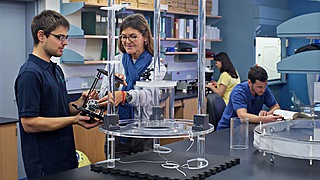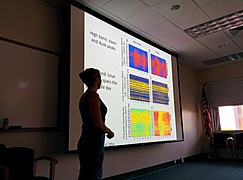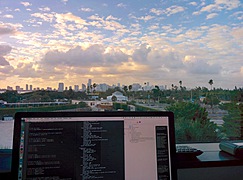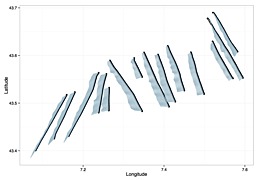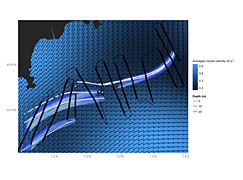Back in Miami to analyse the "tiny" VISUFRONT dataset with a novel method
by Robin Faillettaz, on
Time has been running since my last stay in RSMAS last year… oh no, wait, that was already two years ago! Going back to this lab was a real pleasure. I met the a new member of the Paris Lab, Romain Chaput, who was doing his master's thesis with Claire Paris – supported by PUF. I gave him a hand to sample fish larvae at night and joined the party to pose for the shooting of the Paris’s Lab crew; that was a lot of fun! Because we were both French and had quite similar names we earned the title of "French baguettes"… I was also there just in time to bid farewell to Erica Staaterman, whom I met when she came in Villefranche and then when I was in Miami. She defended her PhD (successfully!) right before I left. Finally, my stay was also the opportunity to discuss about the future, once my PhD (and this PUF project) will be over.
I quickly felt at home there, which put me in good conditions to go deep into the analysis of the VISUFRONT dataset. During the cruise back in 2013, we followed two sampling strategies: first, a "traditional" cross-front transect and, second, a lagrangian approach by continuously sampling a water mass that we tracked with drifters for 36h. Here, I focused on the second part. The objective of my stay was to generate a realistic current field based on the physical data collected during the cruise and to simulate particles inside it with the CMS, the biophysical model developed by Claire B. Paris.
CTD (measuring hydrological variables) and ADCP (measuring currents) sensors were deployed along with "surface" and "deep" drifters during the cruise. You may not remember our older posts, but we had quite a few issues during the cruise, in particular with the GPS. And yes, you guessed it, ADCP data require accurate GPS positioning. Therefore, processing these ADCP data was a cumbersome endeavour, which was made finally successful thanks to the help of L. Prieur (OOV) and C. Heyndrickx (DT INSU, CNRS). We made it! And once we got the physical data processed and ready to use, we included them in an "Objective Analysis", a powerful analysis parametrized with the observed trajectories of the drifters, which provided a comprehensive description of the water mass. Then, we used this newly generated current field with the CMS, to track particles within this water mass. The purpose will be to check if the patches of organisms observed during cruise were simply passively drifting or not. We now have information on larval fish behaviour, so we suspect that at least fish larvae will not be passively drifting. Identifying which behaviour are necessary simulate to match their observed trajectories would provide very interesting data regarding larval fish behaviour and dispersal in the ocean, but this is still a work in progress for now. More to come in the next years !
Here are a few pictures from the Paris Lab shoot, Erica's defense, the view from my office spot in RSMAS (yes I was still focused on the code seen on my screen below), the final ADCP field (after three weeks of hard work!) and the final simulation with ship track in black, actual drifters in white and simulated drifters in shades of blue; we still underestimate actual drift a little but it is much better than what we started from!
